-
Car Reviews
- All reviews
- Midsize SUVs
- Small cars
- Utes
- Small SUVs
- Large SUVs
- Large cars
- Sports SUVs
- Sports cars
- Vans
Latest reviews
- Car News
-
Car Comparisons
Latest comparisons
- Chasing Deals
Jumping on board the hybrid bandwagon as Toyota’s RAV4 Hybrid rockets to the top of the SUV sales charts, the Subaru Forester Hybrid hopes to offer meaningful competition.
On the face of it, Subaru’s Forester Hybrid couldn’t have arrived at a better time. Australians want midsize SUVs, we want them rugged-looking and we’ve warmed to the tech and economy gains of a hybrid drivetrain.
Case in point is our market’s strongest-selling SUV, the Toyota RAV4. Hybrid variants make up a staggering 70% of all RAV4 sales, and Aussies are clamouring for them like little else this side of a Suzuki Jimny. Want a RAV4 Hybrid? Be prepared to join a very long queue.
Into this hungry vacuum lands the Forester Hybrid. For buyers not keen on a six-month (or longer) wait for a RAV4 Hybrid, the stalwart Forester is an obvious alternative. Subaru’s record of delivering comfy family SUVs plus tried and tested all-wheel-drive ability boost its cause, and the Forester has long been Subaru’s best-selling offering here, being so suited to our conditions.
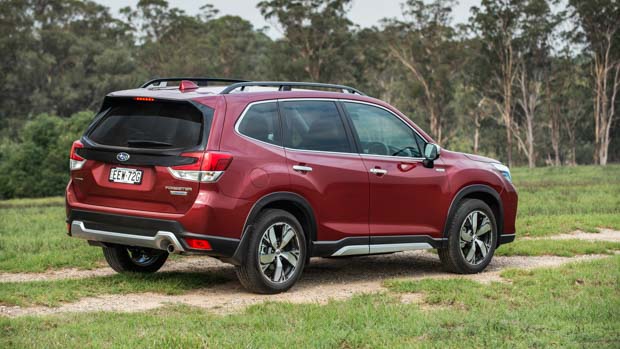
The five-seat Forester range starts at a few slabs under $40,000 on the road, complete with decent features and safety. A 136kW/239Nm aspirated 2.5-litre petrol is common range-wide, until you step into the Hybrids.
These feature a 2.0-litre petrol with 110kW and 196Nm, allied with a small 12.3kW/66Nm electric motor. You’ll need $45,000 to drive-away an entry-level Hybrid L, while our test car, the flagship Hybrid S, is on the road for about $51,500.
Positively, the Forester is a proper Hybrid. That means, just like the Toyota RAV4 Hybrid – and unlike so-called mild hybrids – the electrified Subaru can travel short distances at low speeds (think traffic queues) using just its electric motor.
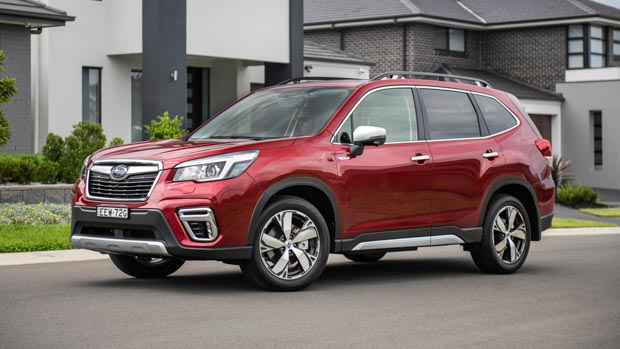
Ideal to reduce your fuel bills in urban areas, with the Forester’s official line being a 19% economy improvement here, or 9% on the combined cycle compared to 2.5-litre petrol variants. Nothing earth-shattering then, and for many, not the improvement you’d expect to justify the extra cost.
The Forester Hybrid’s 6.7L/100km (combined) and 7.5L/100km (urban) fuel use may bring savings versus other Foresters, but it’s roundly trounced by an all-wheel-drive RAV4 Hybrid – it claims 4.8L/100km and 5.0L/100km respectively.
So, can the Forester Hybrid prove itself in other areas to bridge the gap to the excellent, best-selling Toyota rival?
Let’s start with positives. If ease to drive, comfort and excellent visibility are priorities then you’re well served. Massive windows and a high seating position give an air of safety; steering is light and if you’re gentle on the throttle it smoothly ambles around town or up to speed on highways.
Road imperfections are well absorbed, but suspension’s certainly set up for comfort rather than outright handling. It can feel a tad bouncy at speed, and wallows if you get too brave in corners. The cabin’s impressively quiet however, and for general around-town and school run duties it feels in its element.
Not so good are the engine’s response, or thoughts of much driving joy. The CVT gearbox is generally smart and smooth under low loads, but if you ask for some hustle things get whinier and the engine just doesn’t offer the guts to move this 1,700kg SUV along with anything resembling decent speed.
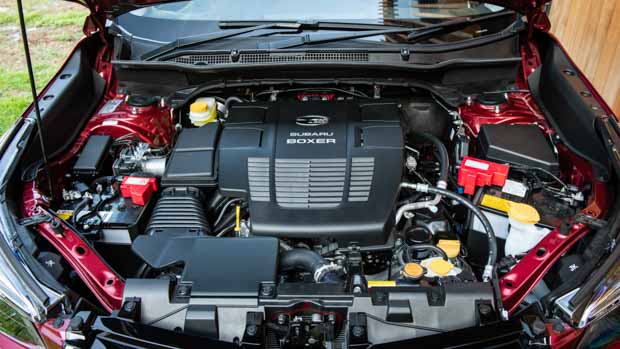
To the hybrid part. When you start up, as long as you just gently tap the throttle it’ll take off in zero-emissions all-electric silence. When you reach 40km/h or prod the accelerator too hard the petrol engine comes to life. Lift-off from speed and the engine subtly switches off and during this coasting phase, or when braking, the lithium-ion battery recharges. There’s no plugging in required to put juice back into the relatively small battery.
In peak hour, school run queues or traffic jams these hybrids are a boon. It’s why you see so many hybrid taxis. As long as the Forester Hybrid’s battery is charged it’ll navigate congestion without burning any petrol: far less annoying (and damaging to your starter motor and battery) than stop-start systems going off and on in traffic.
If you look at the Forester Hybrid as a purely on-road proposition, it feels a decent distance behind the RAV4 Hybrid in terms of drivability and economy. But show the Subaru the unsealed stuff and it feels more the all-rounder. That’s not to say the RAV4 can’t do the basic off-road stuff, but muddy, rocky terrain is far more the Forester’s domain.
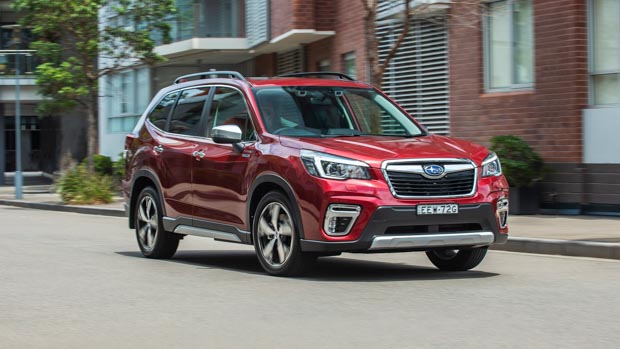
Its 220mm ground clearance helps you forgive it for not tackling corners like a Porsche Macan, while smart X-Mode adjusts gearing and throttle on loose or slippery surfaces. While there’s no low range or diff lock, the Forester stands out as the least soft of the soft roader brigade, helped along with its symmetrical all-wheel-drive system.
We flung it up and down some pretty loose and steep off-road tracks and it felt roundly unflustered. In Snow/Dirt mode it controlled each wheel in impressive fashion, even through some mud-slopped channels after recent heavy rains.
The soft suspension felt well suited to such tracks, absorbing the bigger hits so the passengers didn’t have to. Here’s a real nature-lover trick too. If you slide open the electric sunroof and keep the speed down, you’re off-roading in utter electric-propelled silence with trees and skies above. Only the occasional twig snaps beneath the wheels, as it would under your foot on a bush walk.
For family camping trips or snow escapes, the Forester retains that air of proper suitability to the more off-the-beaten-track work.
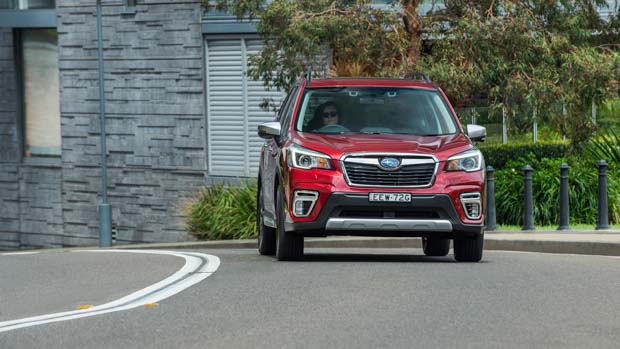
Much like the Forester’s exterior, the cabin’s short on flair and style, instead favouring a plain and safe design and layout. Positively, it feels huge inside. The steering wheel, gear shifter, seats and doors all feel chunky and robust.
This being the range-topper you score sumptuous leather trim, leather-look instrument panel and soft-touch door and dash panel trim throughout. There are power heated front seats, dual-zone climate control, alloy sports pedals, impressive Harman Kardon audio and an 8-inch infotainment display running built-in sat nav plus Apple CarPlay/Android Auto. Decent inclusions, justifying its higher price.
Dragging us back to the 1990s is a CD player – remember those? – while the abundance of buttons on the steering wheel, lower dashboard, centre console and infotainment screen takes plenty of learning. Minimalist? Not here.
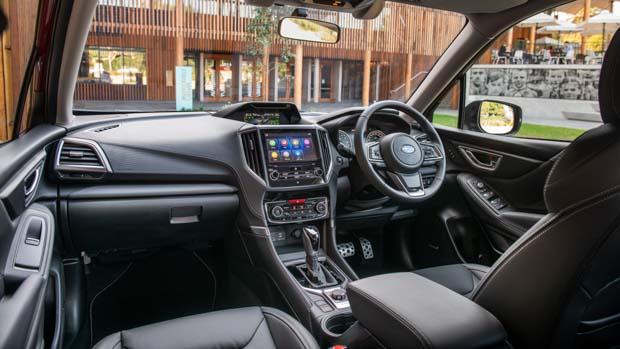
There’s a bit of witchcraft too with facial recognition. An interior camera scans your mug, recognises you and sets the seat and mirrors to your preferred position.
For the family, reclining rear seats are generous with loads of leg and head room, superb big-window visibility and with necessaries such as air vents and a couple of USB slots. Its rear doors are massive for easy entry and exit or comfortably strapping in young kids. Boot’s a reasonable 509L, while an electric tailgate and one-touch electric folding rear seats all give practicality points.
Safety is comprehensive with Subaru’s EyeSight technology, but don’t expect a peaceful experience. The dashboard will flash, beep and pull you back if you get close to a road lane edge or nudge over the speed limit by 1km/h. If your driving is anything but saintly, expect warning messages and warning screens galore. It can be turned off, but that really defeats the point of having it.
Included are very useful side view monitors – great for parking, blind spot and off-road clearance checking – adaptive cruise control, rear cross traffic alert, pedestrian alert, lane keep and change assist, lane departure warning and a good deal more.
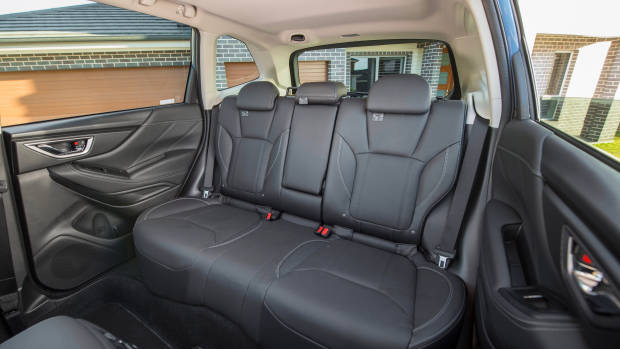
Here’s the rub. On paper you’re not going to be seeing huge reductions in fuel bills by going for the Hybrid version of the Forester. Its combined 6.7L/100km would be expected in a similar-sized diesel SUV (with bags more torque); is some way behind the Toyota RAV4 Hybrid’s economy, and we saw a combined 7.6L/100km across our testing.
As the Hybrid comes with a $3000 premium over the more powerful non-hybrid Forester 2.5i-S, it makes the electrified version a reasonable consideration only to those who’ll be regularly snarled up in congestion.
If we consider the Hybrid weighs nearly 70kg more, drops a full-size spare in favour of a repair kit and can tow only 1200kg versus a non-hybrid’s 1800kg, arguments against the Hybrid gets stronger.

Warranty is five-years/unlimited kilometres – average these days – plus there’s an eight-year/160,000km warranty on the Hybrid’s lithium-ion battery.
Services are every 12-months/12,500km, with the first three-years costing $1,280 or the first five-years $2,430.85. Toyota is renowned for its bargainous capped price services against all others, but it would be remiss to not mention the RAV4 Hybrid costs $645 for three services and $1075 for five.
The Forester Hybrid could well be a smart choice for certain buyers, albeit a niche group. Namely, those stuck in the city snarl during the week then demanding something with decent off-road chops for weekends or holidays.
The hybrid element will drop your fuel bills in urban areas, but it’ll take a long time to recoup that $3000 premium over the conventional, gutsier 2.5-litre petrol Forester without hybrid backup. Overall, the fuel savings aren’t significant enough for the model to make huge sense – clear rival Toyota RAV4 Hybrid on the other hand aces this.
The chance to silently off-road in a capable, comfy and roomy SUV – plus have knowledge you’re reducing your carbon footprint to some extent – will justify the extra spend to some.
Subaru’s Forester remains a compelling all-rounder – in S guise as here, impressively luxurious too – and the Hybrid version is welcome in the line-up. It just doesn’t do the hybrid bit as well as Toyota’s RAV4.
Variant tested HYBRID S (AWD)
Key specs (as tested)
About Chasing cars
Chasing Cars reviews are 100% independent.
Because we are powered by Budget Direct Insurance, we don’t receive advertising or sales revenue from car manufacturers.
We’re truly independent – giving you Australia’s best car reviews.
The estimate provided does not take into account your personal circumstances but is intended to give a general indication of the cost of insurance, in order to obtain a complete quote, please visit www.budgetdirect.com.au. Estimate includes 15%^ online discount.
^Conditions Apply
Budget Direct Insurance arranged by Auto & General Services Pty Ltd ACN 003 617 909(AGS) AFSL 241 411, for and on behalf of the insurer, Auto & General Insurance Company Limited(ABN 42 111 586 353, AFSL 285 571).Because we don’t know your financial needs, we can’t advise you if this insurance will suit you. You should consider your needs and the Product Disclosure Statement before making a decision to buy insurance. Terms and conditions apply.
Indicative quote based on assumptions including postcode , 40 year old male with no offences, licence suspensions or claims in the last 5 years, a NCD Rating 1 and no younger drivers listed. White car, driven up to 10,000kms a year, unfinanced, with no modifications, factory options and/or non-standard accessories, private use only and garaged at night.
^Online Discounts Terms & Conditions
1. Discounts apply to the premium paid for a new Budget Direct Gold Comprehensive Car Insurance, Third Party Property Only or Third Party Property, Fire & Theft Insurance policy initiated online on or after 29 March 2017. Discounts do not apply to optional Roadside Assistance.
2. Discounts do not apply to any renewal offer of insurance.
3. Discounts only apply to the insurance portion of the premium. Discounts are applied before government charges, taxes, levies and fees, including instalment processing fees (as applicable). The full extent of discounts may therefore be impacted.
4. We reserve the right to change the offer without notice.